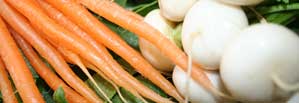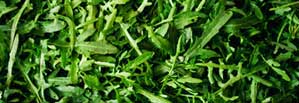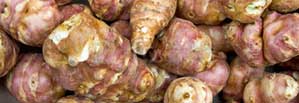|
Hotgame
MAS-HOTGAME™ company is located in the North of Brittany, France, and was created in the 1980's.
In the world of "fruits and vegetable", HOTGAME introduced new concepts, creating and developing the range of baby vegetable and gathering other "original products" like, fine salads, edible flowers, edible seaweeds, ancient vegetables (disappeared from our food habits), edible mushrooms, wild plants, etc... |
Baby cabbage
Baby cabbages are fully part of our range. We do our best to propose them all the year round. Nevertheless, the period extending from June to August is not in favour of their culture under our latitudes. From mid September until April these baby vegetables are in high season.
We propose them in different packages, adapted to each customer.
Those products are part of the baby brassica range and reach a peak in consumption when approaching winter time.
 |
Savoy cabbage Often compared to a flower because of its petal aspect, the baby Savoy cabbage is advantageously consumed stuffed. It can also be a surprise in its entirety in a melting pot. |
|
 |
White cabbage Blanched raw with vinegar to tender them, cooked or raw, stuffed or presented in petals, the baby white cabbage and the baby red cabbage can have different applications and attract specialists of the culinary art. |
|
 |
Red cabbage Blanched raw with vinegar to tender them, cooked or raw, stuffed or presented in petals, the baby white cabbage and the baby red cabbage can have different applications and attract specialists of the culinary art. |
|
 |
Romanesco flower Similar to cauliflower by its aspect and culinary applications, the romanesco is actually a broccoli that comes from Rome area (Italy). |
Baby carott
 |
The baby carrot is a leader in our range. Cultivated in the seafront in sandy fields, it grows easily. Varieties have been selected, so that its aspect and especially its taste satisfy our customers. It is one of the vegetables HOTGAME available all year long and the product is sold under different packages : different sizes of punnets and bunches. |
Baby vegetable
Inventor of the concept of baby vegetables in the beginning of the 1980's, HOTGAME™ goes on year after year completing its range of products.
Neither a fancy of nature, nor an apprentice wizards results, baby vegetables are grown from precise agronomic processes.
The first method used is a selection of the traditional or ancient varieties which possess a reduced size to its ideal development stage, e.g. case of baby courgettes.
A second method consists of growing cultures on high density of crop and using early varieties, harvested slightly before maturity.
Techniques approaching the bonsai culture can also be used in certain cases.
These means of production and harvesting explain why baby vegetables are very tender, fresh and tasty and don't need a lot of time to cook.
 |
 |
 |
 |
| Artichoke | Baby carrot | Baby long turnip | Red beetroot |
 |
 |
 |
 |
| White beetroot | Yellow beetroot | Chioggia beetroot | White cabbage |
 |
 |
 |
 |
| Cauliflower | Red cabbage | Savoy cabbage | Baby courgette |
 |
 |
 |
 |
| Baby Fennel | Baby chicory | Baby round turnip | Baby leek |
Baby Beetroot
Red beetroot
It is the most famous beetroot and one of the first of our products. Of course, it is to be cooked separately from other baby vegetables because of the red colour it gives during the cooking. It must be blanched a bit longer than baby carrots or baby turnips. Baby beetroot leaves can also be cooked.
White beetroot and yellow beetroot
These different sorts of beetroot were found among collector gardeners and their seed is today multiplied by rare small seed producers.
These beetroots are to be prepared just like their well known sister. They offer an additional originality to dishes.
Chioggia beetroot
New one in our range, this beetroot comes from Chioggia, an Italian coastline town, situated on a small island, at the south entrance of the Venice lagoon, in the Pô plain.
When its round root is cut, it unveils superb coloured rings alternating from white to bright pink. After cooking, the flesh turns entirely pale pink – this is why the raw vegetable is preferred. With an early maturation and a more delicate taste, it needs less cooking time than most of others varieties.















